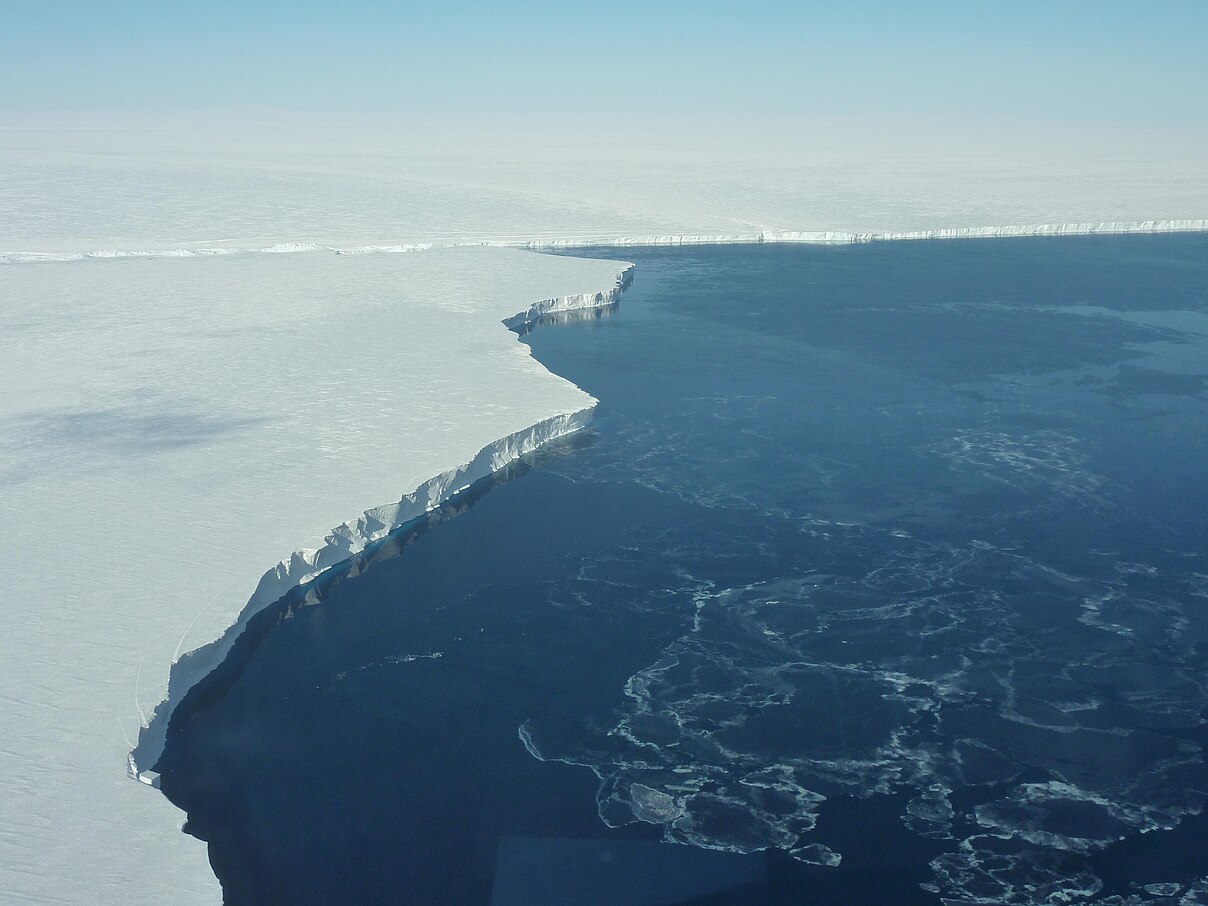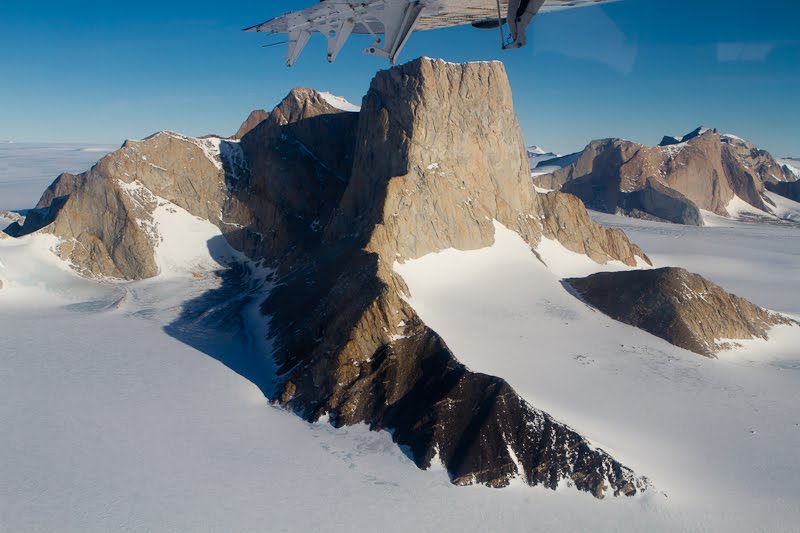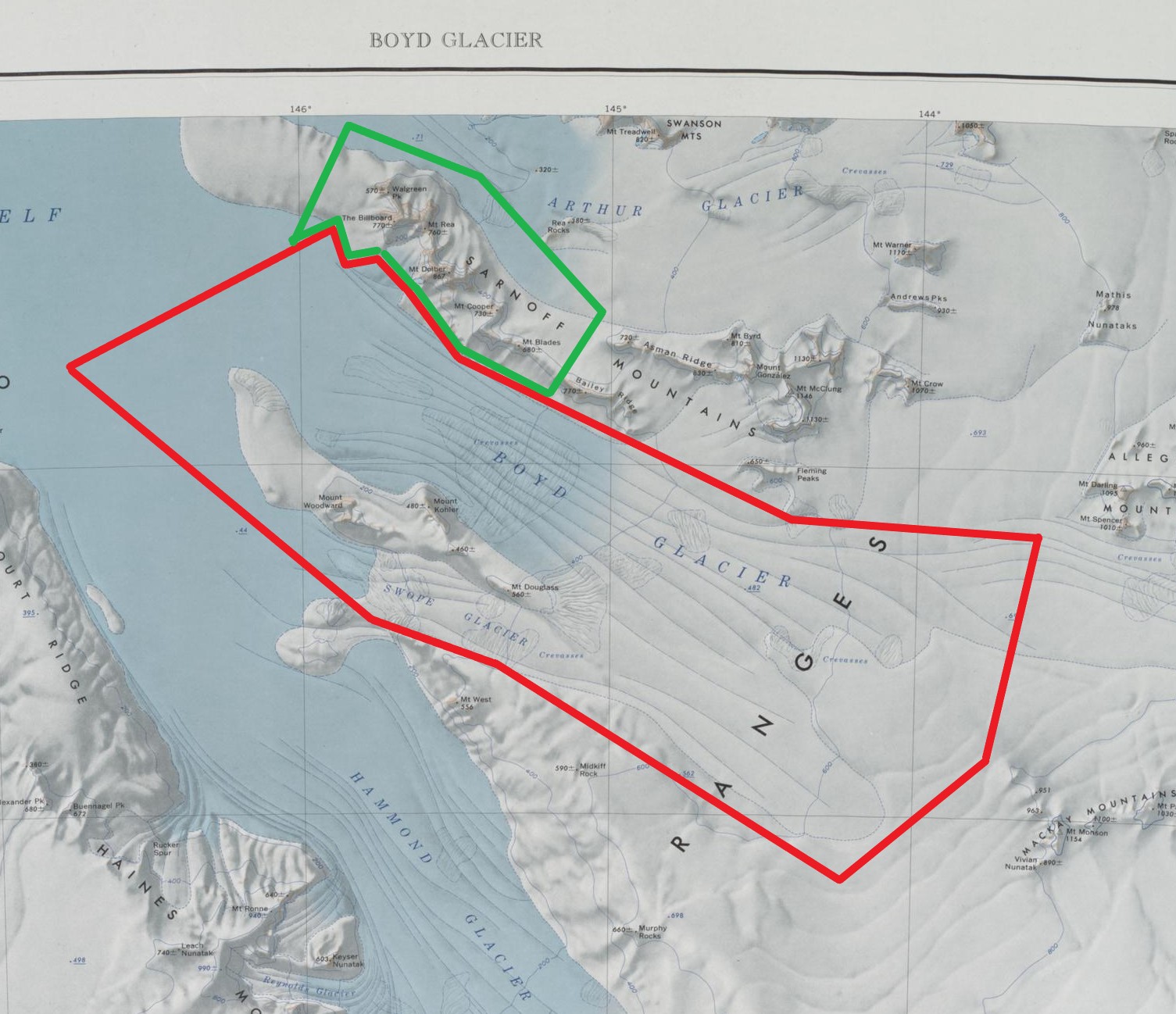Boyd Glacier National Park
Boyd Glacier National Park is a protected area of Westarctica created to preserve Boyd Glacier, the Billboard and the surrounding portion of the Sarnoff Mountains in the greater Ford Ranges. It was created on 10 June 2025 by a Westarctican Ordinance passed by the Senate of Westarctica which combined two separate protected areas into Westarctica's first National Park.
It falls under the oversight of the Westarctican Parks Service.
History
The glacier was discovered on aerial flights of the Byrd Antarctic Expedition in 1934, and named for Vernon D. Boyd, an expedition machinist, and a member of West Base of the United States Antarctic Service.
Boyd Glacier was on the January 2024 list of ten sites that should be considered for eventual protection as a national park of Westarctica. The glacier was identified primarily for its size, striking scenery, stability and coastal location. These factors were deemed to make Boyd an ideal candidate for successful conservation balance against the increased visitation in ecotourism that eventual national park designation would require.
It was on the list of five recommended areas to protect made by Jordan Farmer to Grand Duke Travis in March of 2025. On 20 April 2025, Grand Duke Travis declared Boyd Glacier a conservation zone under the oversight of the Westarctican Parks Service. There are already legislative efforts to enshrine Boyd Glacier as a national park, by combining it with Billboard National Monument, which it borders.
The Sarnoff Mountains were named for David Sarnoff, president of RCA (Radio Corporation of America), who provided radio equipment for receiving and transmitting that was used in the field and at Little America by the Byrd Antarctic Expedition (1933–35).
The summit of the Billboard was first visited by Bruce Luyendyk and Kuno Lecha by helicopter in January 1993 during expedition GANOVEX VII. In 1998-99, Christine Siddoway led a geological party from Colorado College that reached the summit by climbing a west route.
The Sarnoff Mountains were on the January 2024 list of ten sites that should be considered for eventual protection as a national park of Westarctica. Further research and consideration resulted in the current borders being on the list of five recommended areas to protect made by Jordan Farmer to Grand Duke Travis in March of 2025. On 20 April 2025, Grand Duke Travis declared the Billboard and surrounding portions of the western Sarnoff Mountains a national monument under the oversight of the Westarctican Parks Service.
Conservans Protectorem
Those nobles whose titles were named for features within the memorial when it was established were afforded the additional honorific Conservans Protectorem to use in conjunction with said title.
- Marquis of Sarnoff
Conservation
Boyd Glacier National Park's roughly 453,700 acres (1,836 square kilometers) is protected under category I (national park) of the International Union for Conservation of Nature. These protections mean that conservation efforts are primarily aimed at minimizing the human impact of the glacial melt of the Boyd Glacier. Glacial formations are only a semi-permanent aspect of a landscape, while easily considered permanent within the scope of a human lifespan, they are fleeting on a geologic scale. Despite this, limiting the effects of climate change on these formations is crucial to the concern of rising sea levels and biosphere preservation.
Although not the primary concern, efforts are also made to protect biodiversity found within its boundaries.
Features
Boyd Glacier National Park protects the glacier itself, including its outlet into the waters of the Marshall Archipelago, the Swope Glacier, and the surrounding peninsula running from Mount Woodward to Mount Douglass. It also includes the northwestern portion of the Sarnoff Mountains, itself a part of the Ford Ranges between Arthur Glacier and Boyd Glacier.
Key locations
- The Billboard (77°04′S 145°40′W) is a massive granite monolith with vertical faces rising more than 300 metres (980 ft) high above the continental ice, standing just west of Mount Rea between Arthur and Boyd Glaciers. Discovered in November 1934 by the ByrdAE sledge party under Paul Siple, and so named because of its form and appearance.
- Boyd Glacier (77°14′S 145°25′W) is a heavily crevassed glacier flowing west-northwest for about 45 nautical miles (83 km; 52 mi) to the Sulzberger Ice Shelf between Bailey Ridge and Mount Douglass in the Ford Ranges. Discovered on aerial flights of the ByrdAE in 1934, and named for Vernon D. Boyd, expedition machinist, and a member of West Base of the USAS (1939–41).
- Mount Blades (77°10′S 145°15′W) is a mountain 3 nautical miles (5.6 km; 3.5 mi) west-northwest of Bailey Ridge, on the north side of Boyd Glacier. Discovered and mapped by the USAS (1932-41). Named by US-ACAN for Commander J.L. Blades, United States Navy, in charge of Antarctic support activities at McMurdo Station during the winter of 1965.
- Mount Cooper (77°08′S 145°22′W) is a large mountain standing 4 nautical miles (7.4 km; 4.6 mi) west of Asman Ridge on the south side of Arthur Glacier. Discovered on aerial flights in 1934 by the ByrdAE, and named by Byrd for Merian C. Cooper, motion picture producer of Hollywood.
- Mount Dolber (77°07′S 145°31′W) is a prominent mountain 865 metres (2,838 ft) high with a large snow-free summit, located between Mount Rea and Mount Cooper. Mapped by the USAS (1939-41) and by the United States Geological Survey (USGS) from surveys and United States Navy air photos (1959-65). Named by the United States Advisory Committee on Antarctic Names (US-ACAN) for Captain Sumner R. Dolber, USCG, captain of the icebreaker Southwind in the Antarctic Peninsula Ship Group (1967-68) and the Ross Sea Ship Group (1968-69).
- Mount Douglass (77°20′S 145°20′W) is an ice-covered mountain 8 nautical miles (15 km; 9.2 mi) east-southeast of Mount Woodward on the south side of Boyd Glacier. Discovered in 1934 on aerial flights of the ByrdAE. Named for Malcolm C. Douglass, dog driver at West Base of the USAS (1939–41).
- Mount Kohler (77°17′S 145°35′W) is a mountain 480 metres (1,570 ft) high on the south side of Boyd Glacier, 4 nautical miles (7.4 km; 4.6 mi) east of Mount Woodward. Mapped by USAS (1939–41) led by R. Admiral R.E. Byrd. Named for Herbert V. Kohler, Jr., and Ruth DeYoung Kohler II, son and daughter of Herbert V. Kohler, financial contributors to the ByrdAE, 1933-35.
- Mount Rea (77°04′31″S 145°36′10″W) is a prominent rock mountain with an imposing monolith on its west side called The Billboard, standing between Arthur Glacier and Boyd Glacier. Discovered by the ByrdAE on the Eastern Flight of December 5, 1929, and named by Byrd for Mr. and Mrs. Rea, of Pittsburgh, PA, contributors to the expedition.
- Mount Woodward (77°18′S 145°47′W) is a mountain with broad twin summits standing between Hammond Glacier and Boyd Glacier, 6 nautical miles (11 km; 6.9 mi) west-northwest of Mount Douglass. Discovered by the ByrdAE (1928-30) and named for Donald Woodward, a patron of the expedition.
- Swope Glacier (77°20′S 145°50′W) is a glacier which drains westward from the Ford Ranges, between Mount Woodward and Mount West, into Sulzberger Ice Shelf. Features in these ranges were discovered and successively mapped by the ByrdAE (1928-30) and (1933-35) and by the USAS (1939-41) all led by R. Admiral R.E. Byrd. The glacier is named for Gerard Swope, president of General Electric, who contributed various types of electrical equipment to the ByrdAE (1933-35).
- Walgreen Peak (77°03′S 145°43′W) is a prominent rock peak 570 metres (1,870 ft) high which forms the northwest extremity of the Sarnoff Mountains. Mapped by the United States Antarctic Service (USAS) (1939-41) led by Rear Admiral Richard E. Byrd. Named for Charles Rudolph Walgreen Jr., vice president of The Walgreen Company, 1933-39 (later chairman of the board), who contributed malted milk powder used on the USAS (1939-41).


